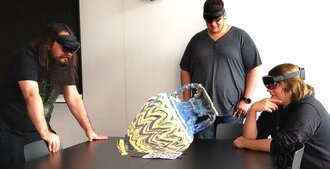
Looking at an ancient find or roaming through catacombs in Italy together - at HFU, research is being conducted into completely new types of teaching experiences.
A research team at Furtwangen University is working on 3D real-time visualisation models
The problem with the excavation sites of ancient treasures is that they are usually very fragile. And often very far away. So, if you're studying archaeology, for example, it is unlikely that you will be able to visit prehistoric monuments with your fellow students - especially during the Corona pandemic. Or is it?
What has long been common practice in excavation projects and museums is now finding its way into teaching – the use of 3D object data. At Furtwangen University, Professor Christoph Müller heads a research team in the "MARBLE" project which is developing such applications. The starting point here is the digitisation of artifacts which are recorded as "point clouds" by laser scanners. Müller and his team are using this data to create new teaching opportunities – using augmented reality glasses, which unlike the virtual reality type, ensure that users do not lose sight of their group or the lecturers. "We develop programming which provides the joint group experience of a tour," Müller explains.
From point cloud to group experience
Through overlays in the glasses, the students experience together, for example, the inspection of an excavation site - in Furtwangen the data of the catacombs of San Gennaro in Italy are currently being prepared. "As participants 'move' through the underground location, their individual perspectives, which change depending on their standpoint, can be described," Müller explains. The project, funded by the Baden-Württemberg Ministry of Science, Research and the Arts as part of the "Teaching4Future with virtual elements" programme, will run until the end of 2022. The results will be implemented as soon as possible by the project partner, the Department of Byzantine Archaeology at the University of Freiburg.
Cooperation with Fraunhofer
As a computer graphics specialist, Professor Müller is also researching the possibilities of 3D visualisation in other fields of application. Whether ancient clay shards or entire city districts - laser scanners, and the point clouds they capture, are always the basis. Müller heads the "Smart Data Visualisation" working group, which was established as a collaboration between the Fraunhofer Institute for Physical Measurement Techniques (IPM) and Furtwangen University. His Fraunhofer team consists of nine researchers, while at the university two researchers are working on this forward-looking technology. "For the laying of fibre optic cables, for example, laser scanners developed by the Fraunhofer IPM and installed on top of cars, used 'mobile mapping' to survey entire city districts. Using special recognition software, factors such as ground conditions were detected," Müller reports. In another project, the routes of house service lines are recorded. This data can be recorded on site using tablets with self-developed software and sensor technology to document where cables, pipes or network connectors have been laid.
Use in construction
The potential for implementing 3D visualisation research in the area of "Building Information Modelling" (BIM) is huge. "Germany is still quite a bit behind in the use of 3D visualisation for construction," Müller confesses. With his team, he is working on developing visual solutions for use on construction sites, for example. "It's all about automated recognition of facts," Müller explains. Artificial intelligence learns to recognise walls and doors in the scanner data - resulting in models that open up completely new possibilities for architects and construction planners. "In concrete applications, it is then also very easy to do an appraisal on construction sites to compare the current state of progress with the plans," says Müller. If the plans can be changed and edited directly in the visualisation, this creates what is known as a digital twin. For the construction industry, Müller predicts, "That's the goal!"